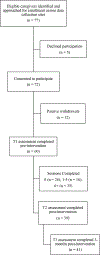Bright IDEAS problem-solving skills training for caregivers of children with sickle cell disease: A two-site pilot feasibility trial
- PMID: 33355983
- PMCID: PMC8665732
- DOI: 10.1002/pbc.28822
Bright IDEAS problem-solving skills training for caregivers of children with sickle cell disease: A two-site pilot feasibility trial
Abstract
Background: Bright IDEAS problem-solving skills training (BI) is an evidence-based behavioral intervention that has been utilized extensively with caregivers of children recently diagnosed with cancer. Considerable evidence has shown that BI is acceptable to caregivers of children recently diagnosed with cancer, and improvements in problem-solving skills mediate reduced symptoms of distress.
Procedures: A slightly modified version of BI was offered to caregivers of children with sickle cell disease (SCD) in a two-site pilot feasibility trial. BI was modified to reduce barriers to care, logistical challenges, and stigma associated with receiving behavioral health services. Our goal was to establish high rates of recruitment and retention among caregivers of children with SCD. Recruitment was acceptable (94%; N = 72) and retention reasonable (49%) across both sites with 35 caregivers successfully completing the BI program.
Results: Results showed that caregivers of children with SCD, who successfully completed the BI program reported, significant improvements in problem-solving skills immediately and three months after intervention completion. Interestingly, initial levels of distress were low with few caregivers reporting clinically significant levels of distress; distress remained low over time.
Conclusions: Findings are discussed in the context of psychosocial screening and resilience of caregivers of children with SCD.
Keywords: Bright IDEAS; caregivers; healthcare disparities; problem-solving; sickle cell disease.
© 2020 Wiley Periodicals LLC.
Conflict of interest statement
CONFLICTS OF INTEREST
The authors have no conflicts of interest to declare.
Figures
Similar articles
-
Feasibility and Acceptability of Bright IDEAS-Young Adults: A Problem-Solving Skills Training Intervention.Cancers (Basel). 2022 Jun 25;14(13):3124. doi: 10.3390/cancers14133124. Cancers (Basel). 2022. PMID: 35804896 Free PMC article.
-
Problem-solving skills training for mothers of children recently diagnosed with autism spectrum disorder: A pilot feasibility study.Autism. 2016 Jan;20(1):55-64. doi: 10.1177/1362361314567134. Epub 2015 Apr 20. Autism. 2016. PMID: 25896269
-
Problem-Solving Skills Training for Parents of Children Undergoing Hematopoietic Stem Cell Transplantation: A Mixed Methods Feasibility Study.Cancers (Basel). 2025 Mar 10;17(6):930. doi: 10.3390/cancers17060930. Cancers (Basel). 2025. PMID: 40149268 Free PMC article.
-
Dissemination of an evidence-based behavioral intervention to alleviate distress in caregivers of children recently diagnosed with cancer: Bright IDEAS.Pediatr Blood Cancer. 2022 Oct;69(10):e29904. doi: 10.1002/pbc.29904. Epub 2022 Aug 4. Pediatr Blood Cancer. 2022. PMID: 35929012 Free PMC article.
-
Mental and Emotional Health of Caregivers of Youth with Sickle Cell Disease: A Systematic Review.J Health Care Poor Underserved. 2023;34(3):1070-1104. J Health Care Poor Underserved. 2023. PMID: 38015138 Free PMC article.
Cited by
-
Feasibility and Acceptability of Bright IDEAS-Young Adults: A Problem-Solving Skills Training Intervention.Cancers (Basel). 2022 Jun 25;14(13):3124. doi: 10.3390/cancers14133124. Cancers (Basel). 2022. PMID: 35804896 Free PMC article.
References
-
- Centers for Disease Control and Prevention Website. https://www.cdc.gov/ncbddd/sicklecell/data.html Accessed August 9, 2017.
-
- Chaturvedi S, Debaun MR. Evolution of sickle cell disease from a life-threatening disease of children to a chronic disease of adults: the last 40 years. Am J Hematol. 2015;91:5–14. - PubMed
-
- Iampietro M, Giovannetti T, Tarazi R. Hypoxia and inflammation in children with sickle cell disease: implications for hippocampal functioning and episodic memory. Neuropsychol Rev. 2014;24:252–265. - PubMed
-
- Lawrence C, Webb J. Sickle cell disease and stroke: diagnosis and management. Curr Neurol Neurosci Rep. 2016;16:1–10. - PubMed
Publication types
MeSH terms
Grants and funding
LinkOut - more resources
Full Text Sources
Medical



